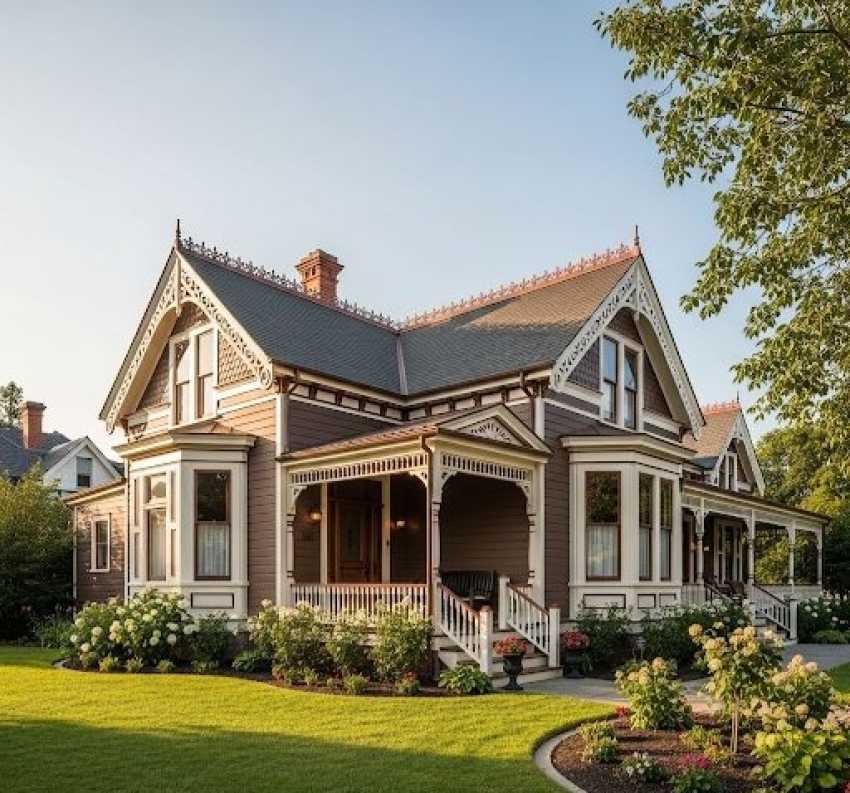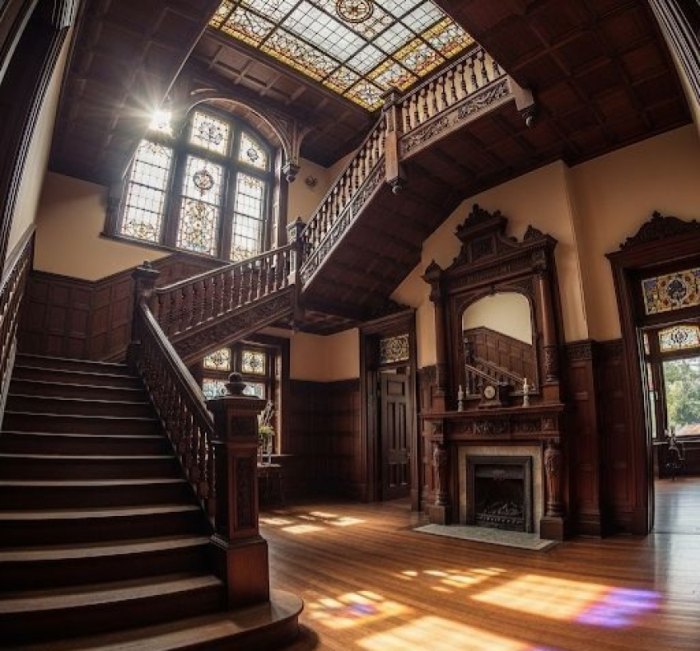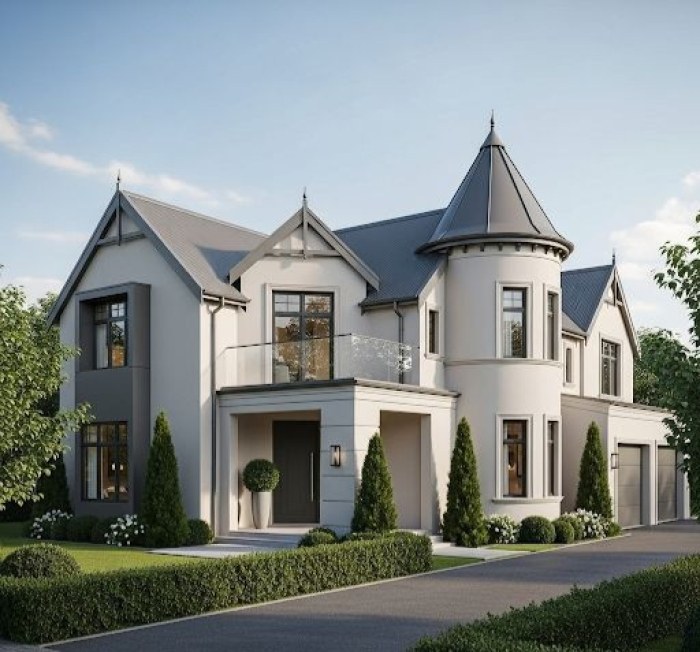Step into a world of intricate details, soaring rooflines, and a touch of romanticism. The mere mention of a Victorian style home often conjures images of charming, dollhouse-like structures, but is that all there is to this iconic architectural style? I’ve always been captivated by the sheer audacity of Victorian design , the way it unapologetically embraces ornamentation and character. It’s a style that has a narrative to share, a history of a bygone day which, to this moment in time, still holds appeal for today’s homeowner.
In a time when home design would tend towards the minimalist, the Victorian style house is a bold and beautiful statement of an era when more was, indeed, more. But are the homes mere relics of the past, or can they actually be incorporated into our contemporary lifestyles? Let’s go on an adventure to learn the enduring appeal of the Victorian style home, from its defining features to its modern revival. Have you ever stood in front of an old grand mansion and wondered who had lived there? That’s the spell that we’re going to untangle.

The Essence of a Lost Era: What is a Victorian Style Home?
The Victorian age, which ran from the 1830s to the early 1900s during the reign of Queen Victoria, was an era of unprecendented change and innovation. This dynamism is also highly evident in the structures of the period. Victorian style home is not a single form of architecture but an overarching term for numerous architectural types that arose during this period. Among these are Gothic Revival, Italianate, Second Empire, Queen Anne, and Romanesque Revival, to mention a few.
This building craze was facilitated by the Industrial Revolution, which created delicate, machine-cut decorative pieces for the first time at affordable prices. Suddenly, the emerging middle class could afford homes that embodied their newfound status, and neighbors started a friendly competition to build the best and most ornate house on the block. The development of the railroad also enabled materials for nationally building to be shipped, the result being a wealth of diverse textures and styles.
There are variations within each of the sub-styles, but they are all bound together by the same strand of exuberance and breaking away from the more sober, classical forms previously seen. Call it a rebellion against architectural blandness.
Unmistakable Hallmarks: The Defining Characteristics
So, what makes a house a Victorian style home? Here are some of the most recognizable features you’ll find:
* Asymmetrical Facades: Forget perfect symmetry. Victorian architects loved to play with complex and irregular shapes, creating visually interesting and dynamic exteriors.
* Steeply Pitched Roofs: Often decorated by gables, dormers, or even a tower or turret, roofs of such homes are a signature. Generally shingled in slate or wood shingles, their steep pitch was practical in colder climates, the potential to shed snow.
* Fussy Trim and Accents: From delicate “gingerbread” trim on the porches and eaves to deep window casings, decoration is the game. This is quite a departure from clean lines in modern design, isn’t it?
* Bay Windows: These window systems that stick out from the wall, often polygonal or square, not only add architectural flair but also light up the interior with natural light.
* Plentiful and Varied Color Palettes: Victorians weren’t afraid of color! Homes were generally painted anywhere from three to seven colors in an effort to highlight their elaborate details, and terrestrial hues like ochre and russet were often punctuated by deep greens and rich burgundies.
To delve even deeper into the context of the time in Victorian architecture, you can browse materials at the Victorian Society in America.

Inside the Victorian Home: More Than a Pretty Face
The opulence of the exterior of a Victorian style home tastefully transfers to the interior. Walk inside, and you’re typically greeted with an orchestra of rich materials, minute detail, and a floor plan that testifies to a bygone era of living. The design of the actual floor plan was even reflective of the social conventions of the time. You would typically have a formal front parlor for receiving guests, typically the most decorated room in the home, and a more private back parlor for household use. The layout also formally separated the servants’ quarters from the family’s living space, sometimes with an independent staircase and workplace space.
Victorian Interior Design Pomp
Victorian interiors were designed to flaunt. This is what you might expect:
- High Ceilings: Intended to provide a sense of roominess and grandeur.
- Ornate Moldings and Plasterwork: From the crown molding on the ceilings to ceiling medallions, no detail was too small.
- Rich Woodwork: Dark, highly polished woods like mahogany, walnut, and oak were used extensively for flooring, staircases, and furniture.
- Intricate Wallpapers: Floral motifs, damask, and geometric patterns were go-to choices, typically in deep, rich colors.
- Ornate Fireplaces: Often the focal point of the room, with very decorative mantels and elaborate tile surrounds.
Doesn’t it feel like every corner of a Victorian style home has a story to tell? For more on incorporating Victorian elements in your own residence, check out our article on Timeless Interior Design Trends on the Serenihouse blog.
The Modern Victorian: A Mashup of Eras
Now you’re probably thinking, “This all sounds great, but can a Victorian style home fit into my 21st-century lifestyle?” The answer is a definitive yes! The new Victorian movement is about striking a balance between preserving historic character and experiencing contemporary comfort and elegance. It’s a design conversation between two eras, and the result can be stunning.
Old Meets New
This is the way homeowners and designers are breathing new life into these gems:
- Open-Concept Living (with a Twist): In contrast to conventional, more compartmentalized Victorian designs of the past, modern remodels seem to require opening up the living spaces, yet still retaining some of the original architectural divisions like archways or pocket doors.
- Light and Bright Interiors: Whereas moody and dark was Victorian, homeowners today prefer having light color schemes to give the rooms an airy and spacious appearance. White walls can be a great way to present a stunning canvas for the home’s original ornate work.
- Contemporary Furniture: Setting contemporary, minimalist furniture against the gaudy backdrop of a Victorian home house creates an interesting and eye-catching space. Imagine a minimalist, sleek sofa set on a vintage hardwood floor under a showy marble mantelpiece.
- Upgraded Kitchens and Bathrooms: Here, functionality is the priority. Chic, upgraded kitchens and spa bathrooms can thrive in an old shell perfectly. Smart home devices and energy-efficient appliances are also being combined effortlessly, proving that you don’t have to sacrifice modern convenience.
Have you ever considered the potential of combining and contrasting different design eras in your own home? For a fascinating look at how architecture styles shift with time, check out this article from the National Trust for Historic Preservation.

Is a Victorian Style Home Right for You?
Having a Victorian style house is certainly a distinct experience. It’s a dedication to maintaining a part of history and a love for craftsmanship that is frequently difficult to come by in new builds. But it’s not without its drawbacks. Maintenance on an older home can be more labor-intensive, and renovations must be done with a delicate touch. You need to be able to handle the realities that accompany a century-old building.
This may include crossing beneath outdated electric and plumbing systems, many of which need to be completely replaced to meet today’s safety standards. You might find hidden layers of lead paint that will need to be professionally abated or discover that original single-pane windows are beautiful but very inefficient. Furthermore, if your home is located within a historically designated district, any work done on the outside might be subject to stringent rules, which can limit your renovation possibilities. Finding craftsmen who are able to restore delicate plaster or woodwork properly can be difficult as well. It’s a labor of love, undoubtedly.
But for people who are attracted to its beauty and character, the reward is priceless. Having a Victorian-style home is a chance to be a caretaker of the past while making a lovely and useful place for the future.
If you’re in the mood for a home with history, search our listings of historic homes for sale to find your own piece of history.
Summary of Key Points
- Victorian style house is a general term for a number of architectural styles during the mid-19th through early 20th centuries.
- Key characteristics are asymmetrical fronts, steep pitches, ornate trim work, bay windows, and bright colors.
- Victorian houses are defined by their high ceilings, rich moldings, lavish woodwork, and ornate fireplaces, with floor plans dictated by the social mores of the day.
- Modern Victorian style blends period charm with contemporary amenities like open floor plans, lighter color schemes, and contemporary comforts.
- Victorian home ownership is a rewarding experience for those who appreciate history and craftsmanship but also entails significant maintenance and specialized remodeling.
Frequently Asked Questions (FAQ)
What is a Victorian-style house?
A Victorian house is usually one that was built during the reign of Queen Victoria (1837-1901) and features the architectural elements of the period, which are usually asymmetrical shape, steeply pitched roof, ornate gingerbread trim, bay windows, and a front-facing gable that protrudes. It’s less a style than an era and therefore encompasses various sub-styles like Queen Anne and Gothic Revival.
Is my house Victorian or Edwardian?
The Edwardian era followed on from the Victorian, although between c.1901 and 1910. Edwardian houses are less flashy than Victorians. They tend to have more straightforward, classical decorations, larger frontages, and greater concern with light and air, with bigger windows and lighter color schemes. If your home has a somewhat less fussy, slightly more “transitional” feel between the grand ornamentation of the Victorian era and the less flashy styles that followed, it could be Edwardian.
How is Queen Anne different from Victorian-type homes?
This is a source of confusion that’s most typical! Queen Anne style is a sub-type of Victorian architecture. Yes, it’s one of the most iconic and desired types of Victorian style home, especially in America. So, a Queen Anne home is a Victorian home. It has its asymmetry, corner towers or turrets, wraparound porches, and multicolored wall textures and hues.
How is a Victorian house different from a Craftsman house?
The Craftsman movement started early in the 20th century as a reaction to the late Victorian era mass-produced ornament. While a Victorian house is all verticality and ornate detail, a Craftsman home is all horizontal, earthy charm and handcrafted quality and natural materials. The houses have low-pitched roofs with wide eaves, exposed rafters, large, tapered columns, and an open interior floor plan.
We hope you found this foray into the world of the Victorian style home informative and inspiring. What do you think about this classic architectural style? Do you love the ornate details, or do you prefer a more minimalist approach? Share your thoughts in the comments below, and don’t forget to share this article with design enthusiasts around the world! For more architectural escapades, be sure to look at the other articles on Serenihouse.com.
